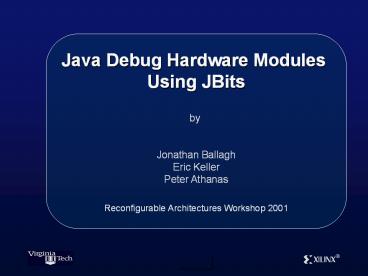Java Debug Hardware Modules - PowerPoint PPT Presentation
Title:
Java Debug Hardware Modules
Description:
Java Debug Hardware Modules Using JBits by Jonathan Ballagh Eric Keller Peter Athanas Reconfigurable Architectures Workshop 2001 Motivation JBits Overview Virtex ... – PowerPoint PPT presentation
Number of Views:59
Avg rating:3.0/5.0
Title: Java Debug Hardware Modules
1
Java Debug Hardware Modules Using JBits by
Jonathan Ballagh Eric Keller Peter
Athanas Reconfigurable Architectures Workshop
2001
2
Overview
- Motivation
- JBits Overview
- Virtex Device Simulator
- Simulator Stimulus
- Hardware Modeling
- RAM Model Example
- Test Bench Design
- Advantages/Disadvantages
- Future Work/Conclusions
3
Motivation
- Want to safely test RTR designs
- Traditional simulators lack RTR support
- Provide more flexibility than traditional
simulators - Black box nature of the configuration bitstream
- Design to bitstream translation is error prone
- Did we get what we wanted?
4
JBits
- A Java API to configure Xilinx FPGA bitstream
- Provides complete design control
- Routing
- CLB configuration
- Supports run-time reconfiguration
- Allows for tools to be built upon it
- Example low-level configuration call
- jBits.Set(row, col, S1F1.S1F1, S1F1.SINGLE_EAST0)
5
The JBits Environment
RTP Core Library
JBits API
User Code
JRoute API
BoardScope Debugger
XHWIF
TCP/IP
Device Simulator
6
Virtex Device Simulator
- Java based simulator for Virtex devices
- Models the FPGA hardware
- Interconnected flip-flops and 4-input LUTs
- Determines state information of Virtex FPGA
- Allows safe validation of designs
7
Virtex Device Simulator
- Supports simulation of RTR designs
- No mechanism for generating external I/O
- The problem
- - How do we do test bench design?
8
Simulator Stimulus
- Manage I/O in a separate process
- SimulatorClient connects to VirtexDS server
- Internal FPGA states travel over TCP/IP
connection
VirtexDS
Simulator Server
Internal FPGA Signals
TCP/IP Connection
Simulator Client
9
Simulator Stimulus
- Signals are probed and stimulated through JBits
Pin resources - Example JBits Pin declaration
- Pin reg_pin new Pin(pin.CLB, 4, 9,
CenterWires.S0_XQ)
Row Column
CLB, IOB, BRAM, or DLL
JBits Resource
10
Simulator Stimulus - Functions
- Pins are read using readPinValue (Pin)
- Vectors are read using readVector(Pin IOPins)
- Pins are written using setPinValue(Pin, int)
- Vectors are written using writeVector(int val,
Pin IOPins) - Method waitForStep() waits for simulator clock to
be stepped
11
Hardware Modeling
- Models extend SimulatorClient class
- Devices are modeled using behavioral Java code
- Examples
- Limited only by the resources available to the
host machine
Memory Processor Control Signal Manipulation
12
Model Operation
- Generic model operation
Initialization
Read Pin Values from Simulator
Determine Next State
File I/O
Write Pin Values to Simulator
Wait for Clock Step
13
Example RAM
- public class RAMClient extends SimulatorClient
- / class member fields /
- private int RAMContents / array
storing memory values / - private Pin addrPins / RAM
address pins / - private Pin dataPins / RAM
data I/O pins / - private Pin RWPin / RAM
read/write pin / - private Pin CEPin / RAM
chip enable pin / - /
- Creates an instance of the RAMClient
- _at_param _addrPins - collection of RAM addr
pins - _at_param _dataPins - collection of RAM data
pins - _at_param _RWPin - RAM read/write pin
- _at_param _CEPin - RAM chip enable pin
- _at_param _RAMContents - RAM memory values
- /
14
Example RAM
while (stepCount lt maxSteps) / obtain RAM
address / address readVector(addrPins)
/ check CEPin status / if
(readValue(CEPin) 0) / active low /
/ check the r/w status / if
(readValue(RWPin) 0) / write /
RAMContentsaddress readVector(dataPins)
else / read /
writeVector(RAMContentsaddress,
dataPins) / end if / / wait for
VirtexDS to be stepped / waitForStep()
stepCount / end while /
15
Test Bench Design
Models
VirtexDS
Vector Files
FPGA
. . ..
. . ..
. . ..
XHWIF
GUI(s)
BoardScope
16
Advantages
- Java language easily models design
- Allows hardware level simulation involving proto
type hardware components - Supports RTR, unlike traditional VHDL simulators
- Testbench can be designed for any Virtex
bitstream - Design tool is irrelevant
17
Disadvantages
- Only supports Virtex devices
- No way to view asynchronous events
- Only one device simulator can be open at a time
- Very low-level
18
Future Work
- Only 1 VirtexDS can be open at a time
- Allow direct access to VirtexDS event queues,
rather than with a TCP/IP connection. - Allow primitives to generate events on external
models. This would allow for better timing
models. - Communication between external modules
- Add asynchronous event support
- Use JBits User Constraints File Parser to
automatically obtain Pin locations
19
Conclusions
- Provides a method to model external hardware
- Allows bitstream level debugging with VirtexDS
- Which means that it supports RTR
- More flexible than VHDL testbenches
- Graphical model representations can be designed
to complement the BoardScope graphical debugger.
20
Questions?































